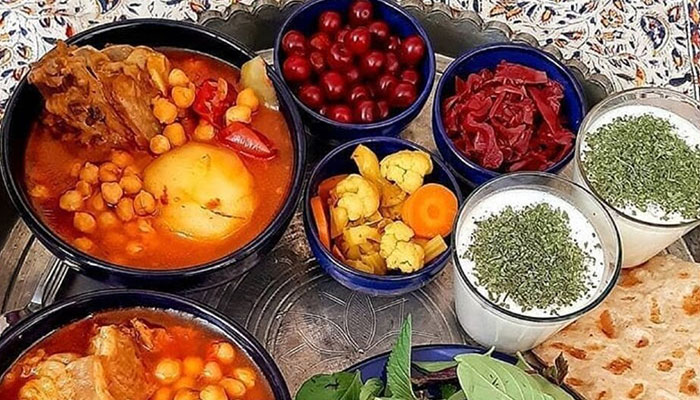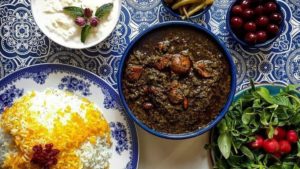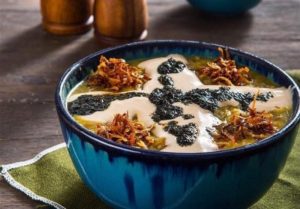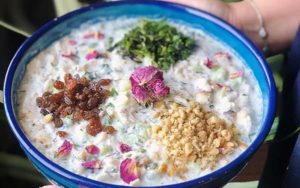
Iranian cuisine has gained popularity worldwide for several reasons. Firstly, Iranian dishes are known for their rich and intricate flavors. Iranian cuisine uses various herbs, spices, and ingredients to create a special mix of flavors. The food includes fragrant saffron rice, tangy pomegranate molasses, and aromatic herbs like parsley, cilantro, and mint. These ingredients combine to add richness and complexity to the dishes. Persian food strikes a balance between sweet, savory, and tangy flavors, creating a delightful experience for the palate.
Secondly, Iranian dishes are prepared with great attention to detail and presentation. The preparation of Iranian food involves time-honored techniques and culinary traditions that have been passed down through generations. From the intricate skewering and grilling of kebabs to the careful layering of rice and meat in Persian dishes like Tahchin, the meticulousness in preparing Iranian food is evident. The visual appeal of the dishes is also important, with vibrant colors, garnishes, and decorative patterns often used to enhance the overall presentation.
Moreover, Iranian cuisine reflects the country’s rich cultural heritage and history. It showcases the influence of Persian, Arab, Turkish, and Central Asian culinary traditions, resulting in a diverse and distinct culinary tapestry. Persian dishes are not only delicious but also a reflection of the country’s agricultural resources, climate, and cultural practices. The use of fresh herbs, seasonal produce, and locally sourced ingredients is highly valued in Iranian cooking, emphasizing the connection between food and nature.
If you plan your trip to Iran, here we provide some useful information to make your trip easier. You can obtain an Iran visa on arrival for your trip and make Iran visa process fast and without any worries. You can also find how to overcome language barriers with a local guide for your travel to Iran.
Here we introduce a list of best Iranian dishes you have to test during your Iran tour.
- Chelo Kabab: Chelo Kabab is a beloved Iranian dish that features skewered and grilled meat. Tender pieces of lamb or chicken are marinated in a flavorful mixture of yogurt, saffron, lemon juice, and spices. The marinated meat is then threaded onto metal skewers and cooked over hot coals or an open flame. When the meat is grilled, it gets a smoky and charred outside but remains juicy and tender inside.
Chelo Kabab is traditionally served with a generous portion of saffron-infused rice, known as “chelo.” The rice is long-grained and fluffy, delicately perfumed with saffron. Alongside the meat and rice, you’ll often find grilled tomatoes and onions, adding a fresh and slightly tangy element to the dish. Don’t forget to try this amazing Persian local food. - Ghormeh Sabzi: Ghormeh Sabzi is a flavorful stew that holds a special place in Iranian cuisine. It is considered one of Iran’s national dishes. The dish contains fresh herbs like parsley, coriander, and fenugreek. These herbs are finely chopped and cooked with tender lamb or beef. The herbs are sautéed to release their aromatic flavors and then combined with cooked kidney beans.
The dish is further enriched with a tangy hint from dried limes and a delightful combination of spices. The long cooking process allows the flavors to meld, resulting in a rich and fragrant stew that is typically served with fluffy rice. This is one of the best Iranian dish you must test when travel to Iran.
- Fesenjan: Fesenjan is a unique and delectable Persian dish that harmoniously combines savory and sweet flavors. It features chicken or duck cooked in a velvety sauce made from ground walnuts and pomegranate molasses. The ground walnuts are toasted and ground into a fine paste, which forms the base of the sauce. Pomegranate molasses is then added to lend a tangy and subtly sweet taste. The chicken or duck is simmered in this luscious sauce, absorbing the rich flavors and becoming tender and succulent.
Fesenjan is known for its complex taste profile, where the nuttiness of the walnuts is beautifully balanced by the fruity and tart notes of the pomegranate. It is typically served with aromatic rice. This is one of the most different Iranian dish you must taste during you tour to Iran. - Zereshk Polo: Zereshk Polo is a delightful Iranian rice dish that features saffron-infused rice studded with vibrant red barberries. The long-grained rice is parboiled and then steamed with saffron-infused water, resulting in a fragrant and golden-hued rice base. Barberries, which are tart and slightly sweet dried berries, are gently mixed into the rice, imparting their ruby red color and tangy flavor. This combination of saffron and barberries creates an eye-catching and flavorful rice dish.
Zereshk Polo is often served with chicken, adding a savory element that complements the tartness of the barberries and the aromatic saffron rice. - Khoresh-e Bademjan: Khoresh-e Bademjan is a delicious eggplant stew that showcases the rich flavors of Iranian cuisine. In this dish, eggplants are first roasted until they become soft and tender. The roasted eggplants are then combined with tomatoes, onions, and a medley of aromatic spices. This mixture is slowly cooked to develop a rich and thick stew. The flavors of the eggplants meld with the tanginess of the tomatoes, creating a harmonious balance.
Khoresh-e Bademjan is often prepared with beef or lamb, which adds meaty depth to the dish. It is typically served with fluffy rice, allowing you to savor the creamy texture of the eggplants and the robust flavors of the stew. - Ash Reshteh: Ash Reshteh is a hearty and nourishing Persian noodle soup that holds a special place in Iranian cuisine, particularly during the Persian New Year. This thick soup features a combination of herbs, legumes such as lentils and chickpeas, and reshteh noodles. The herbs, like parsley, cilantro, and spinach, are chopped and cooked with legumes and noodles, creating a tasty and fulfilling dish.
Ash Reshteh is seasoned with aromatic spices and can be garnished with crispy fried onions, tangy yogurt, and dried mint. It offers a delightful medley of textures and flavors, making it a cherished dish during festive occasions. You can find it in Iran streets and local bazaars as it’s very popular in Iran.
- Baghali Polo: Baghali Polo is a fragrant and aromatic Persian rice dish that combines fluffy rice with dill and fava beans. The long-grained rice is parboiled and then mixed with fresh dill, imparting a refreshing and herbaceous flavor. Tender fava beans are added to the rice, creating a delightful pop of green color and a slightly nutty taste. The rice is then steamed to perfection, allowing the flavors to meld together.
Baghali Polo is often served with tender pieces of lamb or chicken, providing a savory element that complements the fragrant rice and the earthy sweetness of the fava beans. - Kebab Koobideh: Kebab Koobideh is a popular Iranian kebab variety made with seasoned ground lamb or beef. The meat is combined with flavorful spices like onion, garlic, turmeric, and tangy sumac. The well-seasoned mixture is then shaped into long, thin cylinders and skewered. The kebabs are grilled over hot coals or an open flame until they are cooked through and acquire a delicious charred exterior.
Kebab Koobideh is often served with fluffy rice or wrapped in lavash bread, along with grilled tomatoes and onions. The combination of juicy and flavorful meat with the subtle smokiness from grilling creates a mouthwatering culinary experience. - Abgoosht (Dizi): Abgoosht, also known as Dizi, is a traditional Persian local dish that offers a comforting and hearty meal. This stew features tender pieces of lamb or beef, chickpeas, white beans, and potatoes cooked together in a flavorful broth. The meat and legumes are simmered for several hours, allowing them to become tender and infuse the broth with their rich flavors. The result is a satisfying stew that is often enjoyed by mashing the ingredients with pieces of traditional Iranian bread.
Abgoosht/Dizi is a dish that brings people together as it is traditionally served in communal pots, encouraging sharing and conversation while savoring the warm and comforting flavors. It’s highly recommended to ask your local tour guides in Iran to help you find one of the restaurant for Abgoosht. - Saffron Ice Cream (Bastani Sonnati): Saffron ice cream, known as Bastani Sonnati, is a beloved Iranian dessert that offers a delightful combination of flavors and textures. This ice cream is made with a base of creamy ingredients such as milk, cream, and sugar, which are infused with saffron threads. The saffron adds a vibrant golden color and imparts its distinct floral aroma. Chopped pistachios and sometimes pieces of frozen cream are added to the ice cream, providing a rich and nutty element.
Bastani Sonnati is a luscious and creamy treat that beautifully showcases the essence of saffron, a prized spice in Iranian cuisine. Iran provides one of the best kinds of saffron in the world and you shouldn’t miss it in Iran. - Mirza Ghassemi: Mirza Ghassemi is a smoky and flavorful Persian dish that features roasted eggplant and tomatoes. The eggplant is charred over an open flame or roasted until it becomes tender and smoky. The roasted eggplant is then mixed with sautéed tomatoes, garlic, and a medley of aromatic spices. The dish is cooked until the flavors meld together, resulting in a creamy and delicious dip-like consistency.
Mirza Ghassemi is often served as an appetizer and enjoyed with flatbread or alongside rice. It originally comes from north of Iran and you may find one of the best of this Persian local food in a trip to north of Iran. - Tahchin: Tahchin is a delightful Persian rice cake that combines layers of saffron-infused rice with marinated chicken or meat. The rice is parboiled and mixed with yogurt, saffron, and sometimes barberries or other ingredients for added flavor and color. The rice mixture is then layered with marinated chicken or meat in a baking dish and baked until it forms a golden and crispy crust. Once cooked, the Tahchin is inverted onto a serving platter, revealing the beautiful layers of rice and tender meat.
It is a cherished dish for special occasions and gatherings. - Gheimeh: Gheimeh is a comforting and flavorful Iranian stew made with diced meat, typically lamb or beef, and split yellow peas. The meat and peas are simmered together with onions, tomatoes, and a blend of aromatic spices. The dish is slow-cooked until the meat becomes tender and the flavors meld into a rich and satisfying dish.
Gheimeh is often garnished with crispy fried onions and served with fluffy rice. It’s one of the best Persian local food you have to try. - Ab Doogh Khiar: Ab Doogh Khiar, also known as Persian cold yogurt soup, is a highly favored snack and summer dish. It is not only delicious but also considered one of the healthiest foods you can enjoy during the summer season. This refreshing soup provides essential fiber, vitamins, and minerals that your body needs. The inclusion of mint and basil helps to reduce bloating and soothe stomach irritation. The aromatic tarragon adds a delightful flavor to the soup and stimulates the appetite. Cucumbers, another key ingredient, are rich in vitamin C and help to quench thirst.
Yogurt and doogh, the main components of Ab Doogh Khiar, are excellent sources of calcium and protein. Furthermore, this dish includes raisins and walnuts, which are both high in potassium and offer additional nutritional benefits. It’s one of the best Persian local dishes you have to try while you visit to Iran.
- Dolmeh: Dolmeh refers to stuffed grape leaves or vegetables, often filled with a mixture of rice, herbs, and occasionally ground meat. The grape leaves or vegetables are blanched or steamed until pliable and then filled with the rice and herb mixture. They are typically seasoned with a blend of spices and cooked until tender.
Dolmeh is served as an appetizer or part of a mezze platter, offering a burst of flavors and textures. You can find Dolmeh in some restaurant and stores which is one of the best Persian dishes. - Halim: Halim is a popular Iranian breakfast dish made with wheat, meat (usually shredded chicken or beef), and a variety of spices. The wheat and meat are slow-cooked together until they break down into a thick and creamy porridge-like consistency.
Halim is often garnished with cinnamon, sugar, and melted butter, offering a comforting and satisfying meal. It’s one of the best Iranian dishes you have to try. Ask your local tour guide in Tehran to find this in your Tehran tour. - Shirin Polo: Shirin Polo is a sweet and aromatic Persian rice dish made with basmati rice, orange zest, saffron, and a combination of nuts and dried fruits such as pistachios, almonds, raisins, and barberries. The rice is cooked with these ingredients to create a fragrant and flavorful dish.
Shirin Polo is often served with tender pieces of chicken or lamb, adding a savory element that complements the sweet and aromatic rice. - Ashe Mast: Ashe Mast is a refreshing and tangy Persian yogurt soup made with herbs, chopped vegetables, and sometimes rice. The soup combines yogurt with a mixture of fresh herbs like mint and basil, as well as ingredients such as cucumbers and radishes. It is often seasoned with salt, pepper, and dried mint, offering a cool and zesty flavor.
Ashe Mast is particularly enjoyed during hot summer days as a light and refreshing dish. - Sholeh Zard: Sholeh Zard is a fragrant and creamy Persian saffron rice pudding made with rice, sugar, saffron, rosewater, and garnished with cinnamon and slivered almonds. The rice is cooked with water until it breaks down and forms a thick and creamy pudding-like consistency. Saffron threads are added to infuse the dessert with a vibrant yellow color and a delicate floral aroma.
Sholeh Zard is often served cold or at room temperature and is a popular sweet treat enjoyed on special occasions. Don’t forget to test it during your trip to Iran. - Kuku Sabzi: Kuku Sabzi is a flavorful Iranian herb frittata made with a variety of fresh herbs, such as parsley, cilantro, dill, and fenugreek. The herbs are finely chopped and combined with whisked eggs, along with other ingredients like chopped walnuts, barberries, and spices. The mixture is cooked in a pan until it sets into a savory and fragrant frittata.
Kuku Sabzi is typically served at room temperature and is enjoyed as a light meal or appetizer. - Kashk-e Bademjan: Kashke Bademjan is a tasty Iranian side dish made with eggplant, Kashk (a type of whey), onion, and garlic. It is commonly served with bread. This dish originated in Isfahan and Zanjan. For the best results, it is recommended to use eggplants with dark and shiny skin to make a high-quality Kashke Bademjan.
- Oloviyeh salad: Oloviyeh salad originally comes from Russia, but it’s loved by many, especially Iranians, because it’s easy to make. It’s a great choice for parties as finger food. This cold salad is well-known worldwide.
To make Oloviyeh, you’ll need potatoes, boiled eggs, pickled cucumber, canned green peas, lemon juice, chicken, olive oil, mayonnaise, salt, pepper, and carrots. - Dougho Gooshfil: Dougho Gooshfil is a famous and delicious combination in Iran, often associated with the city of Isfahan. It surprises people who haven’t tried it before because it combines two contrasting flavors: salty and sweet. Those who initially hesitate to try this combination often change their minds and even recommend it to others.
The name “goosh fil” comes from its resemblance to an elephant’s ear. Goosh Fil, along with Zoolbia and Bamia, is particularly popular during the month of Ramadan. It’s highly recomended to ask your local tour guide in Isfahan to find this in your Isfahan tour. - Shirazi Salad: Shirazi Salad is a delicious combination of cucumber, tomato, and onion, enhanced by the tangy flavor of lemon juice. It pairs well with almost any rice-based dish and is incredibly easy to prepare. Simply finely chop the cucumber, tomato, and onion, and mix them together. Add a splash of lemon juice, water, and a pinch of salt, then serve. For added freshness, you can also include some chopped parsley or dried mint. Using fresh lime juice instead of store-bought lime juice will provide an even more distinctive and flavorful taste.
The popularity of Persian local dishes can be attributed to its delightful flavors, meticulous preparation, and cultural significance. It offers a unique gastronomic experience that appeals to food enthusiasts around the world, making Persian dishes a cherished part of the global culinary landscape. We recommend you not to miss these best Iranian dishes during your trip to Iran.

Leave a Reply